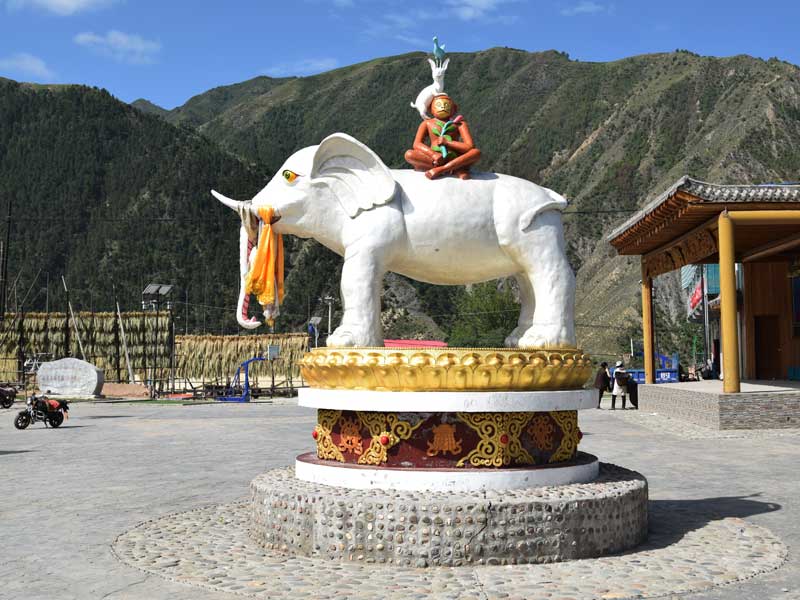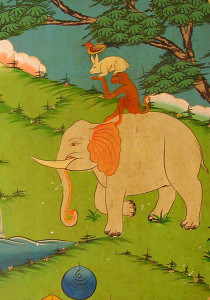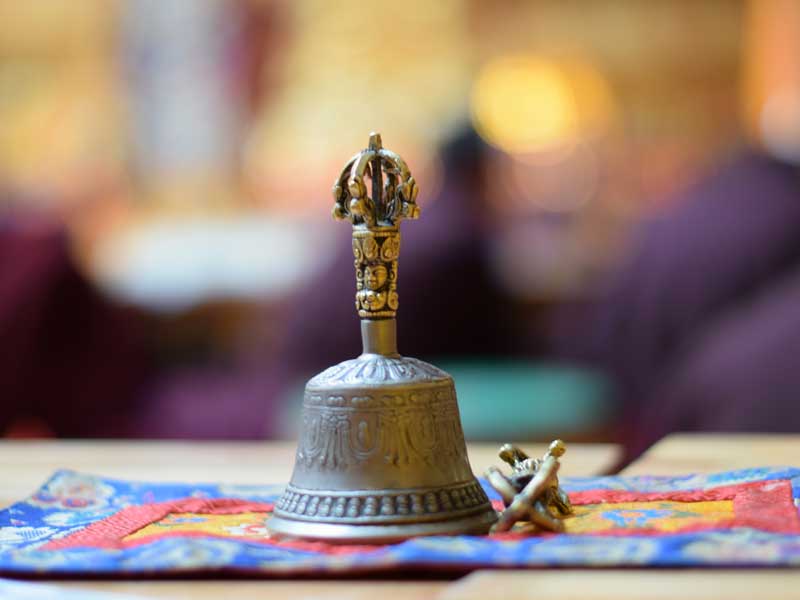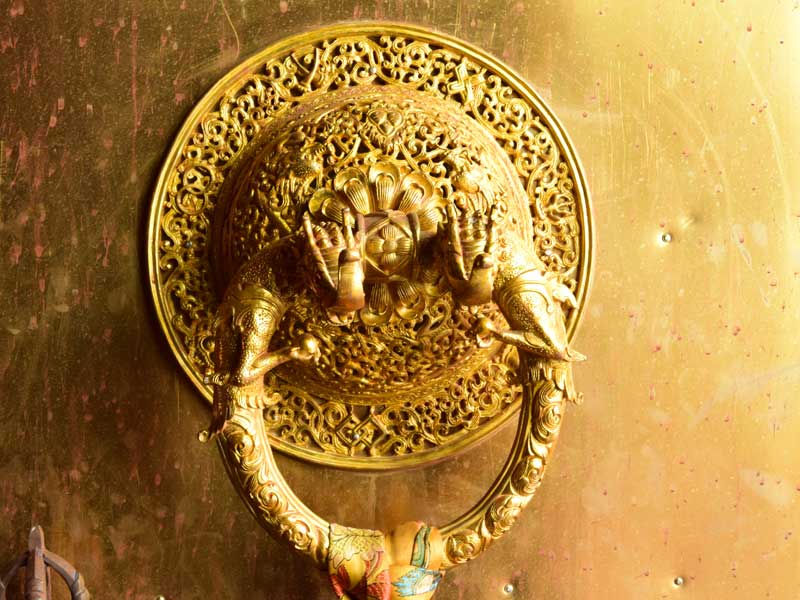The Four Harmonious Brothers can often be seen in Tibetan Buddhist monasteries, monastic dwellings, as well as Tibetan and Mongolian homes. The image depicts an elephant standing next to a tree, with a monkey on its back, a rabbit on the monkey’s back, and a bird on the rabbit’s back, forming a stacked sculpture known as the “Four Harmonious Friends”.
It is also referred to as the “Four Harmonious Beasts”, “Four Harmonious Creatures”, “Four Harmonious Brothers”, and other names.This image symbolizes the cultural values of respecting the elderly and caring for the young, living in harmony, promoting equality and friendship, and practicing mutual respect and love. It expresses the idea of interdependence, helping one another, and the harmony of collective relationships. It is a traditional auspicious image of the Mongolian and Tibetan ethnic groups.
Legend 1
According to the “Chapter on Moral Discipline” in the Buddhist scripture “The Sutra of the White Lotus Flower,” there is a story about the Four Harmonious Brothers. The story goes as follows:
Long ago, in a dense forest, there lived a white elephant, a monkey, a white rabbit, and a bird. They lived harmoniously, helping each other, and happily coexisting.
One day, they decided to show respect to the eldest among them. After discussing, they decided to determine the order based on the height they were when they first saw the tall Lhazha tree.
The elephant spoke first, saying, “When I was young, I was the same height as the tree.”
The monkey followed, saying, “When I was young, I was also the same height as the tree.”
After hearing their statements, everyone concluded that the monkey was older than the elephant.
The rabbit continued, “When I saw this tree when I was young, it only had two tender leaves.”
Based on the previous statements, they agreed that the rabbit must be older than the previous two.
Finally, the bird (hornbill?) said, “Back then, I ate the seeds of this tree in a distant place. When I flew here, the seeds came out of my droppings and grew into this big tree.”
At this point, they realized that the bird was the oldest, followed by the rabbit, then the monkey, and although the elephant was physically large, it was the youngest. From then on, the four animals lived together in harmony, respecting each other’s seniority. When facing rough paths, the elephant would carry the monkey, the monkey would carry the rabbit, and the rabbit would carry the bird on its head, encouraging and supporting each other, overcoming difficulties, and becoming as close as a family.
Legend 2
A legend tells the story of the Four Harmonious Brothers as follows:
A hornbill bird brought a seed and dropped it on the ground. A rabbit saw it and dug a hole to bury the seed in the soil. Soon, the seed sprouted into a sapling. A monkey playing in the forest saw it and, to protect the sapling, used branches to create a fence around it and removed the surrounding weeds. When a elephant saw this scene, it started watering the small tree with water from a mountain spring using its long trunk. With the careful nurturing of the Four Harmonious Brothers, the sapling grew into a towering tree, bearing abundant fruits. However, the tree was too tall for anyone to reach the fruits. So, the elephant allowed the nimble monkey to climb onto its back, the monkey let the lightweight rabbit stand on its shoulders, and the rabbit lifted the bird, who finally plucked one fruit after another with its sharp beak. Everyone under the tree enjoyed the sweet fruits. They then shared the delicious fruits with all the animals in the forest.

Inspired by this experience, the Four Harmonious Brothers made a vow to practice virtuous deeds. The bird encouraged its companions to observe the five precepts (abstaining from killing, stealing, sexual misconduct, false speech, and intoxication) and encouraged all beings around them to do the same. Through their influence and persuasion, the animals in the forest gradually learned to live harmoniously, refraining from harming each other and living peacefully in the forest. Due to their practice of virtuous deeds, even the heavens responded with harmonious rainfall. As a result, the crops flourished, plants thrived, and beautiful flowers bloomed. The whole country experienced a bountiful harvest and prosperity.
In this legend, the bird is considered the past life of Shakyamuni Buddha, the rabbit represents the venerable Shariputra, the monkey represents the venerable Maudgalyayana, and the elephant represents the venerable Ananda.
This fable later became used in a religious context to emphasize the importance of harmony, social morality, and the practice of virtuous deeds. It is often accompanied by the “Four Harmonious Brothers” image, which symbolizes harmony and unity.
Legend 3
“The Four Auspicious Beasts of Harmony” is derived from the “Jataka Tales” in Buddhism. According to the scripture, there was once a country called “Kashyapa”. This country had been plagued by continuous wars and unrest for years. Suddenly, one year, the people found peace and the conflicts ceased. The king, thinking that this was a result of his own blessings, became proud and delighted, believing that he had brought prosperity to the nation.
One day, the king encountered a wise sage. This sage had attained supernatural powers through his constant meditation and always spoke the truth. The sage told the king, “The peace and happiness of the people are not due to the king’s blessings, but rather the result of the collective merits generated by the harmonious coexistence of the Four Auspicious Beasts in a valley within your kingdom.” Intrigued, the king personally led his entourage to investigate the valley. There, they saw a large elephant standing by a tree, with a monkey on its back. The monkey, in turn, carried a rabbit, and the rabbit carried a bird. The sage explained, “The arrangement of these four animals symbolizes the king’s and the nation’s respect for the elderly and the importance of harmony. The small bird, residing in the valley, fertilizes the seeds in the soil. When the seeds grow into flourishing trees, they provide food for the rabbit. When the trees bear fruit, they meet the needs of the monkey. Finally, when the trees grow large, the elephant takes shelter under their shade. The Four Auspicious Beasts prioritize age and promote harmony, coexistence, and respect for both the young and the elderly. The merits of the Four Auspicious Beasts have blessed your country with the peace it enjoys today.” Upon hearing this, the king felt deep respect and ordered his people to learn the ways of respecting the elderly and living harmoniously.
Since then, this tale has been frequently cited in ancient Indian culture and Tibetan Buddhism to emphasize the importance of harmonious coexistence and social moral order. It is often accompanied by the depiction of the “Four Auspicious Beasts of Harmony” as a symbol of harmony and auspiciousness.
1: “Four Harmonious Brothers” originally comes from the Jataka tales. In the Han texts unearthed in Dunhuang, there is a passage called “The Four Animals’ Causal Connections,” which has the same content as the Jataka tales.
2: Similar stories about the “Three Harmonious Brothers” are found in Volume 34 of the “Ten Recitations Vinaya” and Volume 5 of the “Fourfold Vinaya.” However, what is recorded is the “Three Harmonious Brothers”
3: Buddhism often has scriptures specifically dedicated to animal stories, such as the “Sutra of One Hundred Parables,” “Nine-Colored Deer Sutra,” and “Deer Mother Sutra.” “Four Harmonious Brothers” is one of the representative stories.
Paraphrase of Four Harmonious Brothers
The elephant in Tibetan is “གླང་ཆེན” (langchen). It represents Maudgalyayana, symbolizing auspiciousness, good fortune, and complete blessings.
The monkey in Tibetan is “སྤྲེའ” (tre). It represents Shariputra, symbolizing harmony and wisdom.
The rabbit in Tibetan is “རི་བོང” (ri bong). It represents Ananda, symbolizing various auspicious and excellent qualities.
The hornbill bird in Tibetan is “བྱ་སྲེག་པ” (jya sreg pa). It represents the Buddha, expressing respect and reverence for the wise.
Creation of Four Harmonious Brothers
Later, based on the stories of these four animals in Buddhist scriptures, a auspicious design called the “Four Harmonious Friends” was created.
The design depicts a beautiful pure land reminiscent of Shangri-La, with a flourishing tree bearing sweet fruits. In front of the tree, there is an elephant carrying a monkey on its back, with the monkey holding a fruit and a rabbit sitting on the back of the rabbit. On the back of the rabbit, there is a hornbill bird.
The Four Harmonious Friends design portrays a scene of mutual respect, love, sharing of flowers and fruits, unity, and harmony among the four animals. The four friends symbolize respect for the elderly, love for the young, and peaceful coexistence. It expresses the Tibetan people’s desire for a united, harmonious, peaceful, and tranquil life.
In general, the four animals are arranged in a pyramid shape in the picture, with the hornbill bird at the top, followed by the rabbit, monkey, and elephant, supporting each other.
Usage of Four Harmonious Brothers
In Tibetan Buddhism, animal stories are often used to illustrate Buddhist principles. They are vivid, lively, and easy to spread, serving as effective teaching tools.
The “Four Harmonious Friends” design is very popular in Tibetan and Mongolian regions. It can be seen in temples, monasteries, and homes. They are usually painted on the doors and walls of temple corridors, or on tables, beds, bottles, and tents.
The design can take various forms, such as thangka paintings, murals, embroidery, carvings, etc. It can also be used as butter flower decorations for offerings, symbolizing the good wishes for family harmony, happiness, and auspiciousness.














